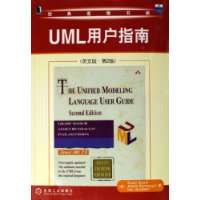UML用户指南(英文版•第2版)
标 签:UML 面向对象 软件工程及软件方法学 综合 语言与开发工具 程序语言与软件开发 计算机与互联网
历经十载,UML(统一建模语言)已经成为可视化、详述、构造和文档化软件密集型系统工件的工业标准。UML作为事实上的标准建模语言,有力地促进了项目相关人员之间的沟通,大大降低了沟通中出现混乱的几率。而UML2.0规范更进一步扩展了UML这门语言的适用范围和生命力。其内在的丰富表现力使得用户可以建模从企业信息系统和分布式基于Web的应用到实时嵌入式系统的任何事物。
本书介绍了UML的基础知识,包括UML的术语、规则和语言特点,以及如何运用该语言去解决各种应用领域中的复杂建模问题。书中给出了大量实例,这种基于实际应用的学习方式,有助读者迅速掌握UML的基本概念、独特性质及应用。
在第2版中保持了第1版论述全面深入、由实例驱动的特点,并彻底更新了内容以符合UML2.0规范。
新增内容包括:
新增一章介绍组件和内部结构,内容包括用于构造封装设计的新技术。
新增和更新了所需接口、协作和UML profile的内容。
新增和修改了有关顺序图、活动图等的讨论。
增加了由UML2.0规范引入的一些新变化。
三位软件工程界巨匠——Grady Booch、James Rumbaugh以及Ivar Jacobson是统一建模语言(UML)的创始人,他们因对创立对象技术的卓越贡献而为全世界所共知。除本书外,他们还合著了另两部名著:《UML参考手册》和《统一软件开发过程》。
Preface vii
Part I Getting Started 1
Chapter I Why We Model 3
The Importance of Modeling 4
Principles of Modeling 8
Object-Oriented Modeling 10
Chapter2 Introducing the UML 13
An Overview of the UML 14
A Conceptual Model of the UML 17
Architecture 32
Software Development Life Cycle 34
Chapter3 Hello, World! 37
Key Abstractions 38
Mechanisms 41
Artifacts 43
Part 2 Basic Structural Modeling 45
Chapter4 Classes 47
Getting Started 47
Terms and Concepts 49
Common Modeling Techniques 54
Hints and Tips 59
Chapter5 Relationships 61
Getting Started 62
Terms and Concepts 63
Common Modeling Techniques 69
Hints and Tips 74
Chapter6 Common Mechanisms 75
Getting Started 76
Terms and Concepts 77
Common Modeling Techniques. 84
Hints and Tips 88
Chapter7 Diagrams 89
Getting Started 90
Terms and Concepts 91
Common Modeling Techniques 96
Hints and Tips 101
Chapter 8 Class Diagrams 103
Getting Started 103
Terms and Concepts 105
Common Modeling Techniques 106
Hints and Tips 113
Part 3 Advanced Structural Modeling 115
Chapter 9 Advanced Classes 117
Getting Started 117
Terms and Concepts 118
Common Modeling Techniques 130
Hints and Tips 131 1
Chapter 10 Advanced Relationships 133
Getting Started 134
Terms and Concepts 135
Common Modeling Techniques 148
Hints and Tips 149
Chapter 11 Interfaces, Types, and Roles 151
Getting Started 151
Terms and Concepts 153
Common Modeling Techniques 157
Hints and Tips 161
Chapter 12 Packages 163
Getting Started 164
Terms and Concepts 165
Common Modeling Techniques 170
Hints and Tips 174
Chapter 13 Instances 175
Getting Started 175
Terms and Concepts 176
Common Modeling Techniques 182
Hints and Tips 183
Chapter 14 Object Diagrams 185
Getting Started 185
Terms and Concepts 187
Common Modeling Techniques 188
Hints and Tips 191
Chapter15 Components 193
Getting Started 193
Terms and Concepts 194
Common Modeling Techniques 203
Hints and Tips 206
Part 4 Basic Behavioral Modeling 207
Chapter16 Interactions 209
Getting Started 210
Terms and Concepts 211
Common Modeling Techniques 221
Hints and Tips 222
Chapter 17 Use Cases 225
Getting Started 225
Terms and Concepts 228
Common Modeling Techniques 236
Hints and Tips 237
Chapter 18 Use Case Diagrams 239
Getting Started 239
Terms and Concepts 241
Common Modeling Techniques 242
Hints and Tips 248
Chapter19 Interaction Diagrams 249
Getting Started 250
Terms and Concepts 251
Common Modeling Techniques 261
Hints and Tips 265
Chapter 20 Activity Diagrams 267
Getting Started 268
Terms and Concepts 269
Common Modeling Techniques 280
Hints and Tips 284
Part 5 Advanced Behavioral Modeling 285
Chapter 21 Events and Signals 287
Getting Started 287
Terms and Concepts 288
Common Modeling Techniques 293
Hints and Tips 296
Chapter22 State Machines 297
Getting Started 298
Terms and Concepts 300
Common Modeling Techniques 315
Hints and Tips 318
Chapter 23 Processes and Threads 319
Getting Started 320
Terms and Concepts 321
Common Modeling Techniques 326
Hints and Tips 330
Chapter 24 Time and Space 331
Getting Started 331
Terms and Concepts 332
Common Modeling Techniques 335
Hints and Tips 338
Chapter25 State Diagrams 339
Getting Started 340
Terms and Concepts 341
Common Modeling Techniques 343
Hints and Tips 347
Part 6 Architectural Modeling 349
Chapter26 Artifacts 351
Getting Started 351
Terms and Concepts 352
Common Modeling Techniques 355
Hints and Tips 360
Chapter27 Deployment 361
Getting Started 361
Terms and Concepts 362
Common Modeling Techniques 366
Hints and Tips 368
Chapter28 Collaborations 369
Getting Started 369
Terms and Concepts 371
Common Modeling Techniques 376
Hints and Tips 382
Chapter 29 Patterns and Frameworks 383
Getting Started 383
Terms and Concepts 385
Common Modeling Techniques 389
Hints and Tips 394
Chapter 30 Artifact Diagrams 395
Getting Started 395
Terms and Concepts 396
Common Modeling Techniques" 398
Hints and Tips 407
Chapter 31 Deployment Diagrams 409
Getting Started 409
Terms and Concepts 411
Common Modeling Techniques 413
Hints and Tips 419
Chapter 32 Systems and Models 421
Getting Started 421
Terms and Concepts 423
Common Modeling Techniques 426
Hints and Tips 428
Part 7 Wrapping Up 431
Chapter 33 Applying the UML 433
Transitioning to the UML 433
Where to Go Next 435
AppendixA UML Notation 437
Appendix B Rational Unified Process 443
Glossary 451
Index 463
装 帧:平装
页 数:475
版 次:1
开 本:16开
